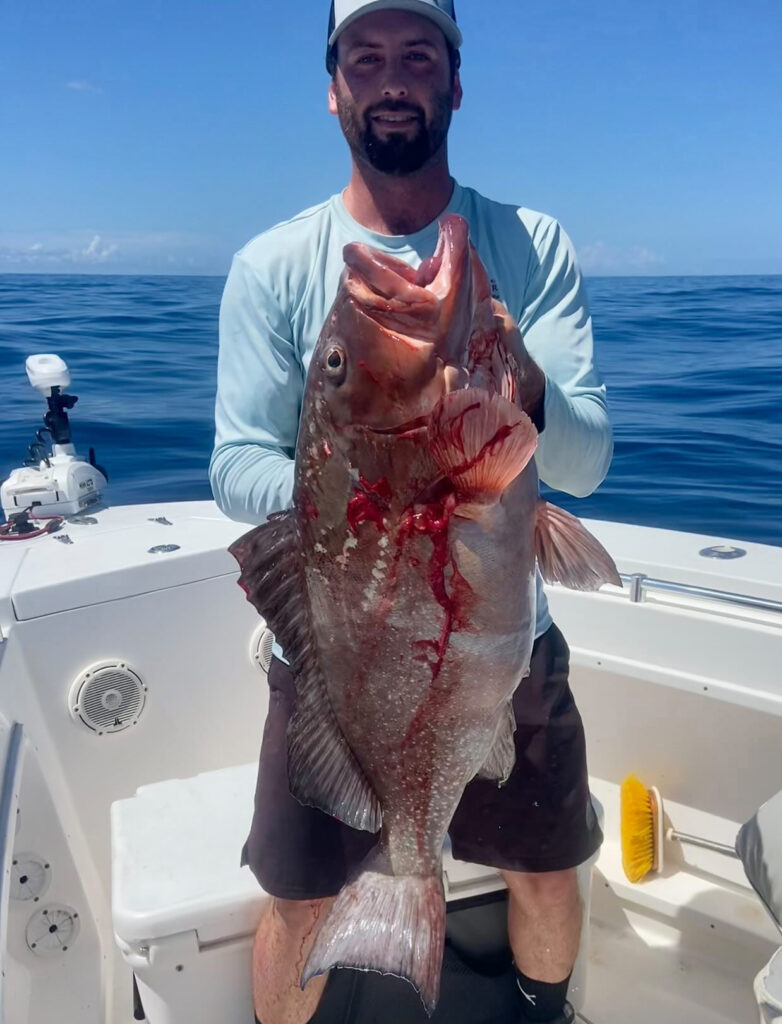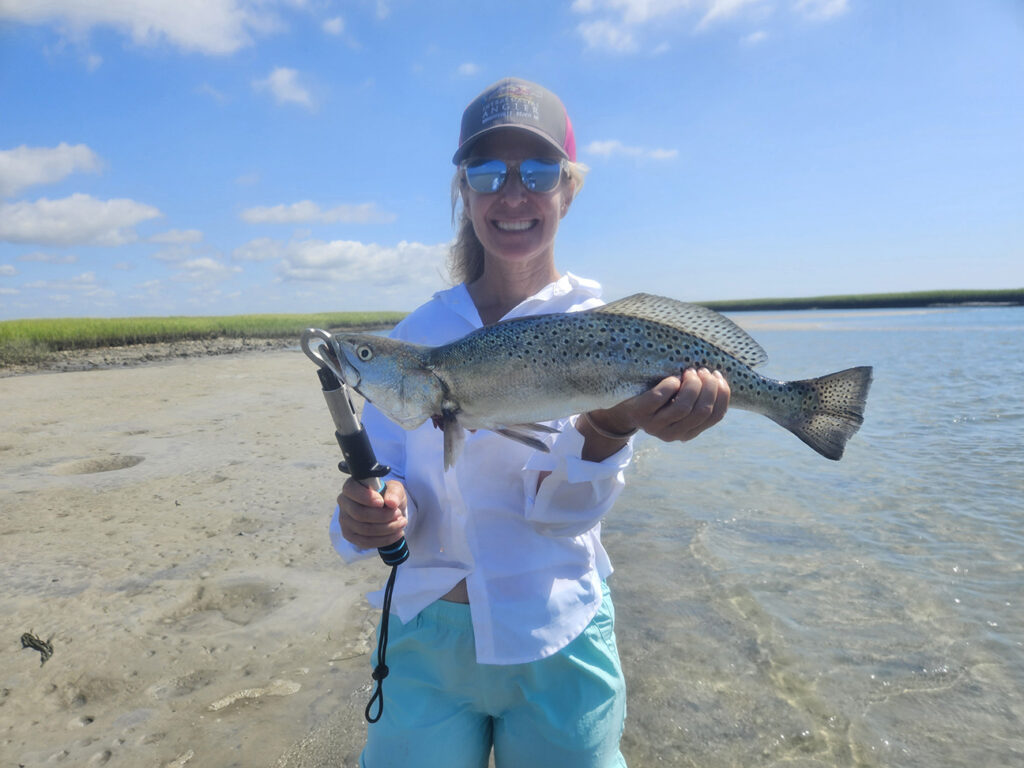Topsail/Sneads Ferry – August 2024
Jerry, of East Coast Sports, reports that nearshore anglers are finding a decent number of spanish mackerel outside the inlet and out along the beachfronts.
The king mackerel action remains best out in the 10+ mile range, with a few scattered fish caught shallow along the beach.
Based on the few boats able to get offshore, some wahoo and scattered mahi are out in the Gulf Stream.
Inshore anglers have been focused on the red drum action. This is a great time of year to pull out those topwater plugs first thing in the morning before the sun is up and everything gets hot. Once the morning is over, Carolina-rigged live bait will produce most of the strikes. Target grass lines, oyster beds, and other hard structure regardless of what tactic you choose
Fishing fiddler crabs or shrimp around pilings, docks, and other hard structure should entice black drum and some sheepshead.
Mike, of Native Son Guide Service, reports that anglers are seeing action on speckled trout in the 17-20” range. There hasn’t been a ton of them, but the numbers are certainly respectable for the middle of summer. The bite has been best when targeting current seams with topwater plugs early in the day, and then switching over to soft plastics after that first light.
A bunch of red drum are staged up on grass flats just inside the major creeks. Topwater plugs have had success in the early mornings, and on cloudy days, the action has continued as late as 10:00 am.
Some bigger (upper-slot and over-slot) red drum are scattered around docks in the ICW. Most are being caught by anglers fishing mullet under popping corks or cut pogies on the bottom.
Boats able to get off the beach have found bluefish and some spanish mackerel.
For days the wind doesn’t allow an ocean run, spanish mackerel can also be caught just inside the inlet on the final part of incoming tide and right at high tide.
A bunch of flounder are around for anyone fishing bottom-rigged live baits.

Capt. Jake Rimes, of Hampstead, NC, found this 25 lb. red grouper 50 miles offshore of Surf City using a cigar minnow. He was fishing with Capt. Ken Chaveria.
Ray, of Spring Tide Guide Service, reports that the strongest fishery right now are red drum. The action has included a bunch of over-slots (to 32”) in the area, and they’re mixed in with slot fish. The best producer has been artificials, such as topwater plugs, and the biggest advantage to using topwaters is being able to cover ground better. Live baits are also have plenty of success, but anglers need to work an area well and stay a little longer than normal, as the warm water temperatures have fish very lethargic to react.
Some speckled trout are mixed in the action throughout the ICW, especially in areas closer to the inlet. The trout bite is really dependent on being out first thing in the morning.
Sheepshead are another summertime staple in the area, with anglers having success when targeting them on hard structures.
Spanish mackerel fishing has been sporadic.
Chadwick, of South End Anglers, reports that anglers have been finding red drum staged just about everywhere from grass lines, oyster beds, and docks, to creeks and bays in the marsh.
Flounder fishing has been really good both inshore and over nearshore structure. Live menhaden or finger mullet on a Carolina rig will attract attention from the flatfish.
Nearshore bottom structure is also holding variety of black sea bass, grunts, snapper, grouper, and triggerfish.
There are plenty of amberjacks and barracuda to play with on the ARs. Live pogies, surface poppers, and Yo-Zuri stick baits will get them to strike.
Jim, of Plan 9 Charters, reports that trolling remains the top tactic for spanish mackerel, with small Drone spoons or smaller Clarkspoons (#00 sized) fished behind planers or trolling weights being the best bet.
Some king mackerel are up on the beach and feeding right beside the spanish mackerel. The potential for a king is a good reason to be pulling a big plug or ballyhoo in your nearshore spread. A decent king mackerel bite is also in the 10-mile range.

Tara D’Alessandro, of Wilmington, hooked this speckled trout while fishing near Figure Eight Island using a live mullet.
Joe, of Atlantic Sportfishing, reports that anglers are catching some mahi and good king mackerel while trolling dead baits. Both species are being found starting in the 30-mile range.
Some mahi are inside of 30 miles. They are scattered and very thinned out, but anywhere in the 10-30 mile range can produce a random, slinger-sized mahi.
Bottom fishing has included keeper scamp grouper and red grouper in the 100’+ area.
Starting at 90’+, there’s a good mix of vermilion snapper, triggerfish, porgies, grunts, and big black sea bass.
Gulf Stream runs are producing wahoo, blackfin tuna, and the larger mahi.
Robin, of Jolly Roger Pier, reports that anglers fishing off the end have landed some large tarpon (to 75 lbs.), king mackerel (to 23 lbs.), and good-sized spanish mackerel.
When the water conditions are clean, some pompano are being caught.
Cut baits fished during the day have produced bluefish, and anglers fishing at night are catching sea mullet and speckled trout.
Vinita, of Surf City Pier, reports that live baits fished off the end are producing king mackerel (to 20+ lbs.) and a larger class of spanish mackerel (to 5+ lbs.).
Anglers have landed some keeper speckled trout at night.
Bluefish are hitting bottom-fished baits during the day, and croakers and pinfish round out the rest of the bait soaking action.
Tyler, of Seaview Pier, reports that anglers at the end of the pier have been seeing huge tarpon passing by. Any day now, the pier should see a hookup.
A good class of spanish mackerel are being caught with live baits being fished on king rigs.
When water conditions are clean, bluefish and spanish mackerel are being caught with casting jigs.
The best bottom fishing has been happening at night. Anglers have caught a mixed bag of black drum, sea mullet, and speckled trout.
